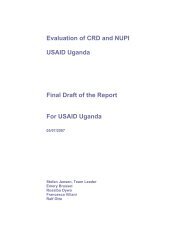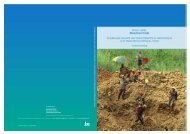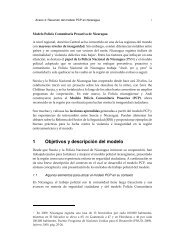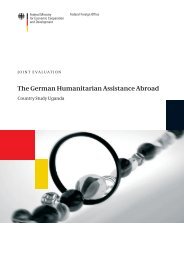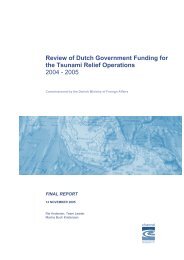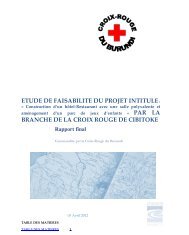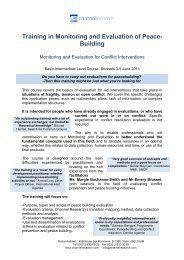A ripple in development? - Channel Research
A ripple in development? - Channel Research
A ripple in development? - Channel Research
Create successful ePaper yourself
Turn your PDF publications into a flip-book with our unique Google optimized e-Paper software.
Provid<strong>in</strong>g support to local <strong>in</strong>dividuals and organisations requires<br />
an approach with a flexible and long fund<strong>in</strong>g timeframe. Organisations<br />
that have been able to provide support successfully to local capacities<br />
are seen to be dist<strong>in</strong>ct from “service delivery” agents, and <strong>in</strong>tegrate their<br />
plans <strong>in</strong>to national programmes. For example <strong>in</strong> Indonesia, IFRC efforts<br />
<strong>in</strong> support<strong>in</strong>g health and pandemic preparedness <strong>in</strong> the area are <strong>in</strong> l<strong>in</strong>e<br />
with the government emphasis on appropriate technology use. Health<br />
care support was identified by IFRC as one of four key goals <strong>in</strong> Indonesia.<br />
By the end of 2008, over 184 hospitals and cl<strong>in</strong>ics were rehabilitated<br />
and operational 93 . However, emergency medic<strong>in</strong>e rema<strong>in</strong>s an area<br />
where more government and civil society capacity can be built. Health<br />
system recovery and epidemic prevention are priorities identified <strong>in</strong><br />
Indonesia’s Master Plan for Rehabilitation 94 .<br />
Such a harmonious relationship naturally depends on an able local<br />
coord<strong>in</strong>ation. The alignment between the UN, NGOs and the government<br />
has benefited from BRR work and operations and has built capacity<br />
<strong>in</strong> the sector to promote effective community participation. Alignment<br />
with <strong>development</strong> strategies was more difficult <strong>in</strong> the eastern Sri<br />
Lanka conflict areas. CADREP played an active role <strong>in</strong> align<strong>in</strong>g support<br />
with the local partner capacities. UNDP po<strong>in</strong>ted out that, “CADREP<br />
acted as a bridge between the CSO and GO” to unfold recovery actions,<br />
but CADREP performance was dependent on the local adm<strong>in</strong>istration’s<br />
capacity specific to district and sector.<br />
Some of the largest capacity support efforts of the <strong>in</strong>ternational<br />
community, such as CADREP, have been successful at develop<strong>in</strong>g<br />
national policies and authorities, but have been less successful <strong>in</strong> spark<strong>in</strong>g<br />
local preparedness plans and effective grassroots emphasis on risk<br />
reduction. The result can be that when care is not taken these large<br />
programmes detract from support to smaller <strong>in</strong>itiatives—<strong>in</strong>clud<strong>in</strong>g<br />
those that address gender issues—at district and subsidiary levels.<br />
Furthermore, there is not an agreed <strong>in</strong>ternational system available<br />
for promot<strong>in</strong>g capacity to respond to and recover from large-scale disasters.<br />
Most standards and quality assurance measures are aimed at deliver<strong>in</strong>g<br />
water, sanitation, shelter, and now livelihood and <strong>in</strong>stall<strong>in</strong>g compla<strong>in</strong>ts<br />
mechanisms. Even if participation is mentioned across the<br />
Sphere standards (Humanitarian Charter and M<strong>in</strong>imum Standards <strong>in</strong><br />
Disaster Response), there are no standards for support<strong>in</strong>g local capacity<br />
to manage water, sanitation, or shelter recovery needs, especially through<br />
<strong>development</strong> stages. Donor priorities are low on this agenda, even if<br />
Pr<strong>in</strong>ciple 8 of the Good Humanitarian Donorship <strong>in</strong>itiative <strong>in</strong>dicates<br />
that donors should “strengthen the capacity of affected countries and<br />
local communities to prevent, prepare for, mitigate and respond to<br />
humanitarian crises…” Capacity <strong>development</strong> cont<strong>in</strong>ues to mean many<br />
93<br />
IFRC (2008a)<br />
94<br />
Republic of Indonesia (2005, p. IV–7)<br />
102




